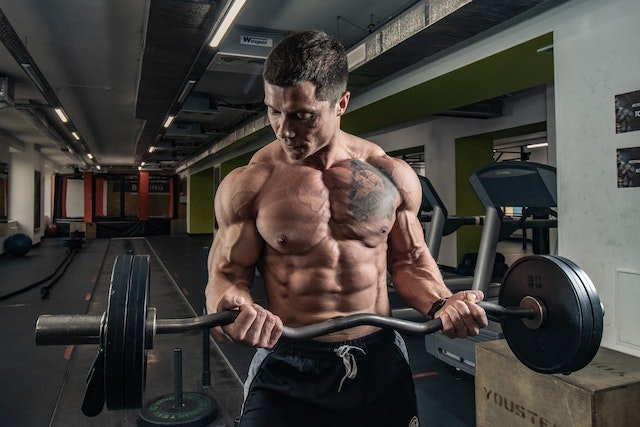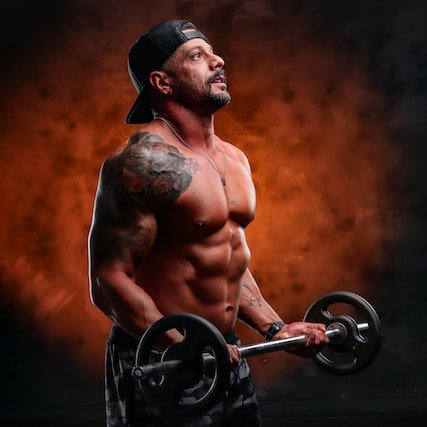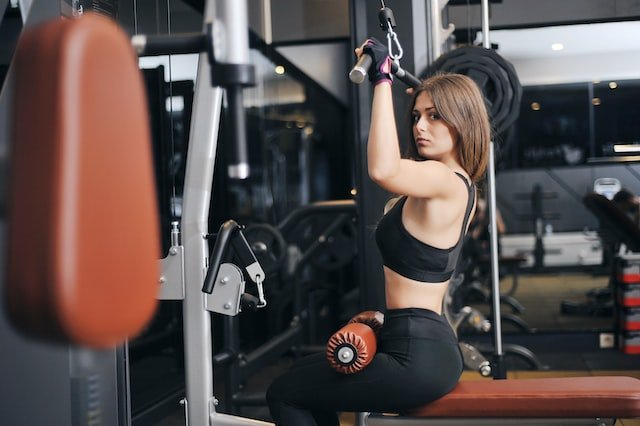
Are Bicep Curls a Pain In your Neck? Answers For Pain Relief And Progress Here
If you’ve ever done bicep curls, you might have noticed a strange sensation in your neck.
It leaves you to wonder “why do I feel bicep curls in my neck”.
That’s because the muscles in your neck and shoulders help to stabilize your arms during this exercise. What we are going to do is find out why this happens and how to prevent it.
We’ll also provide tips for optimizing your bicep curl technique. Let’s get started!
Why do I feel bicep curls in my neck?
One of the main reasons why you might feel bicep curls in your neck is because of poor form. When doing bicep curls, it’s important to keep your shoulders down and back, and your chin tucked, with your head in a neutral position. If you’re not doing this, then your shoulders and neck will start to round forward, which puts unnecessary strain on these muscles. Trying to watch the bar as you curl the weight can also cause neck pain, as you aren’t keeping a straight spine. Another reason why you might feel bicep curls in your neck is that the weight is too heavy. If you’re using a weight that’s too heavy for you, your body will compensate by recruiting other muscles, such as those in your neck and shoulders, to help lift the weight. To avoid this, make sure to use a weight that’s appropriate for your level of strength and fitness. If you’re not sure, start with a lighter weight and gradually increase the amount of weight you’re using over time.
What muscles are in our neck?
The muscles in our neck work to move the head and support the weight of the head. These muscles include the trapezius, levator scapulae, sternocleidomastoid, and the scalenes.
If you’re doing bicep curls with good form, then these muscles should not be engaged. However, if you aren’t doing them correctly, then these muscles can become overworked, leading to pain and discomfort.
Let’s look at ways you will feel bicep curls in your neck and ways to rectify the problem and get back to bicep curls pain-free.
Poor form
One of the most common mistakes people make when doing bicep curls is using poor form. This can lead to a number of problems, including neck and shoulder pain.
When done correctly, bicep curls should be performed with the palms facing up and the elbows tucked in close to the body. The weight should be lifted using the muscles in the upper arm, not the neck or shoulders.
People often feel bicep curls in their necks because they are using momentum to lift the weight, rather than engaging the muscles properly.
This puts unnecessary strain on the neck and can lead to pain and injuries. Using proper form when doing bicep curls is essential for preventing injury and achieving results.
Too heavy and ego lifting
Why do I feel bicep curls in my neck? It’s simple anatomy. Your biceps attach at the front of your shoulder, and their primary job is to lift your arm.
However, they also attach to the lower part of your neck, so when you do a bicep curl, you’re also activating the muscles in your neck. This can lead to tension and pain, especially if you’re already carrying a lot of stress in your upper body.
To avoid this, try focusing on exercises that target the biceps without putting strain on the neck, such as dumbbell curls or preacher curls.
Ego lifting with weights too heavy is another common cause of neck pain during bicep curls.
When you use a weight that’s too heavy for you, your body will recruit other muscles to help lift the weight. This can lead to strain and pain in the neck and shoulders.
To avoid this, make sure to use a weight that’s appropriate for your level of strength and fitness.

Dipping head to lift the weight and Watching the curl
Dipping your head to look at the curl as you lift the weight is a common mistake that many people make when doing bicep curls.
Though it may seem like dipping your head will give you better form, it actually puts unnecessary strain on your neck muscles and joints, plus it can lead to injury, due to the fact you’re holding your head in an unnatural position.
When you dip your head, you are effectively moving the weight of the curl forward, which puts more pressure on your neck and spine.
Additionally, watching the curl as you lift can also cause you to arch your back, which can lead to pain and discomfort. Instead of dipping your head or watching the curl, focus on maintaining good form by keeping your back straight and your shoulders in line with your hips.
Try to keep your head in a neutral position and focus on lifting the weight rather than watching it. This will help to minimise strain on your neck and allow you to get the most out of your bicep curl workout.
Related: Why Do I Feel Bicep Curls In My Triceps? Problem Solved For Rapid Results
Tension in shoulders and traps
When you do a bicep curl, your shoulder and trap muscles contract and pull on the muscles in your neck. This can cause tension and even pain for some people.
When these muscles are tight, they can pull on the tendons that attach them to your bicep, which can lead to pain in your bicep as well.
To avoid this, you need to stretch these muscles before working out. Try doing some shoulder shrugs and traps stretches to loosen up these muscles.
Regular stretching and massages can help to loosen the muscles, and exercises that strengthen the surrounding muscles can help to take some of the strain off of the shoulders and traps.
In addition to causing pain and discomfort, this can also lead to impingement syndrome, a condition that can limit your range of motion.
If you experience pain or discomfort when doing bicep curls, stop the exercise and consult a doctor or physical therapist to determine the cause.
By addressing the root cause of the problem, you can get rid of the pain in your neck when doing bicep curls for good.
Face strain
Another common cause of neck pain during bicep curls is face strain. When you curl your biceps, the muscles in your face contract as well.
However, this happens more whenever we are straining to lift a weight that’s too heavy for us because we are doing all we can to shift the weight in question.
For example, try gritting your teeth for a few seconds and see how it makes you feel. Now imagine doing that for a few minutes while also trying to curl a heavy weight.
Not only is it going to be difficult to maintain good form, but it will also put a strain on the muscles in your face and neck muscles too.
This can lead to pain in the temples, jaw, or even the eyes. To avoid this, try to relax your face when doing bicep curls. You can also try to use a lighter weight so that you’re not straining as much.
Focus on maintaining good form by keeping your back straight and your shoulders down and back.
Additionally, make sure to take breaks often so that your facial muscles can relax. Neck pain during bicep curls is a common problem, but it doesn’t have to be.
By understanding the causes of neck pain and taking steps to prevent it, you can enjoy your workouts without pain or discomfort.

Could it be nerve pain?
If the pain you’re feeling in your neck is more like tingling or numbness, it could be due to a compressed nerve.
One of the nerves that run through the neck is the ulnar nerve. This nerve can become compressed when you do bicep curls, especially if you use a weight that’s too heavy.
If this nerve becomes compressed, it can cause pain, tingling, or numbness in the neck, arm, or hand. To avoid this, try to use a lighter weight and focus on maintaining good form.
You should know and feel the difference between muscular pain and nerve pain though. As muscular pain is normally dull and achy, nerve pain is sharper and shooting.
I have had nerve pain in the past, and believe me…you will know the difference, as nerve pain can be excruciating.
If you experience any tingling or numbness, stop the exercise and consult a doctor. compressed nerves can be serious and should be treated by a medical professional.
Related: Why Is One Arm Stronger Than The Other? (All The Answers For Perfect Symmetry)
Muscle imbalances
One of the most common causes of neck pain is muscle imbalances. When the muscles in your shoulders and traps are stronger than the muscles in your chest and back, it can lead to pain in the neck.
This is because the stronger muscles will pull on the weaker muscles, which can lead to pain and discomfort. To avoid this, focus on strengthening the muscles in your chest and back.
You can do this by doing exercises like push-ups, pull-ups, and rows. You should also focus on stretching the muscles in your shoulders and traps.
Imbalances can also happen when people have an unbalanced workout schedule and they choose certain exercises over others because those particular exercises suit them more. They might see better results from the chosen exercise, feel it working more or simply dislike other exercises.
By evening out the muscles in your upper body, you can help to prevent neck pain when doing bicep curls.
Poor posture
One of the main reasons why people experience neck pain is due to poor posture. When you have poor posture, it can lead to several problems, including neck pain.
When performing bicep curls, it’s important to maintain good posture. This means keeping your shoulders down and back, your chin tucked, and your head in a neutral position.
It will also help to focus on maintaining good posture throughout the day. This means standing up straight with your shoulders back.
You can also try exercises that help to improve your posture. These include yoga, Pilates, and Tai Chi.
Additionally, make sure to sit up straight when you’re working at a desk or table. Use a chair that supports your back and make sure your computer screen is at eye level.
By improving your posture, you can help to prevent neck pain when doing bicep curls.
Have you pulled a muscle?
This may sound obvious, but sometimes the pain you’re feeling in your neck is due to a muscle strain. You may not know that you’ve pulled a muscle until you feel the pain.
This can happen if you use a weight that’s too heavy or if you don’t warm up properly before your workout.
In some cases, it can be from something as trivial as sleeping in a funny position or turning your head too sharply which can cause the muscles and ligaments in your neck to become strained.
If you think you may have pulled a muscle, stop the exercise and rest the muscle. You can also apply ice to the area for 20 minutes at a time, several times a day.
Powering through workouts with the old “no pain, no gain” philosophy is not only outdated but can also lead to serious injuries. If you’re feeling pain, it’s important to listen to your body and take a break.
If the pain doesn’t improve after a couple of days or if it gets worse, consult a doctor. You may need to take medication or get physical therapy to treat the muscle strain.

Fatigued muscles
Another common cause of neck pain is muscle fatigue. This can happen when the muscles in your neck and shoulders are overworked.
This can be from doing too many repetitions of an exercise, using a weight that’s too heavy, or simply not giving your muscles enough time to recover.
When your muscles are fatigued, they can’t work as efficiently and this can lead to pain. To avoid this, make sure to give your muscles plenty of rest between workouts.
Additionally, make sure to warm up properly before your workout and cool down afterwards. This will help to prevent your muscles from becoming fatigued.
If you find that your muscles are still becoming fatigued, try lightening the weight or doing fewer repetitions.
We tend to neglect the fact that our neck muscles need just as much attention as the rest of our muscles.
By giving your neck and shoulder muscles a break, you can help to prevent pain when doing bicep curls.
Related: Why Do I Feel Bicep Curls In My Back? Everything You Need To Know For Rapid Progress
Weak traps
The trapezius is a large, triangular muscle that extends from the base of the skull to the middle of the back. It’s responsible for stabilizing the shoulder girdle and moving the shoulders.
When your traps are weak, they can’t stabilise your shoulder blades properly, which puts a lot of strain on your neck muscles.
The upper traps are the strongest part of this muscle, while the lower traps are weaker. As a result, when doing bicep curls, it is not uncommon to feel some fatigue in the lower traps and even in the neck.
While this is not necessarily cause for concern, it is important to be aware of your form and to avoid arching your back or swinging your arms as you curl. Doing so can help to minimize any strain on the lower traps and neck.
If the trapezius muscles are weak, it can lead to neck pain. This is because the muscle isn’t able to properly support the weight of the head.
To strengthen the trapezius muscles, do exercises that target them. These include shrugs, upright rows, and lateral raises.
Not engaging upper body and core
When doing bicep curls, it’s important to engage not only your arms but also your upper body and core. This will help to stabilize your body and prevent you from swinging your arms as you curl.
If you don’t engage your upper body and core, your body will compensate by recruiting other muscles, such as those in your neck and shoulders. This can lead to pain and even injuries.
To engage your upper body and core, make sure to keep your shoulders down and back, and your chin tucked. Your head should be in a neutral position.
It’s also important to keep your abs engaged and to avoid arching your back. Doing so will help to prevent any strain on your neck and shoulders.
Bicep curls performed with a loose or wobbly body can put strain on the neck and shoulders. The muscles in these areas must work harder to keep the body stable.
Isolate biceps
To take the strain off of your neck and shoulders, try doing curls that isolate the biceps completely, with such exercises as the preacher curl and concentration curl.
In the preacher curl, you place your arms on a padded bench with your palms facing up. From here, you curl the weight up and squeeze your biceps at the top of the curl.
The concentration curl is performed by sitting with one hand holding the weight and tucking your elbow into the side of your inner thigh. From here, you curl the weight up and squeeze your biceps at the top of the curl.
Doing exercises that. You then curl the weight up, keeping your elbow close to your side.
Both of these exercises allow you to focus solely on the biceps, without involving the shoulders or neck. As a result, they are much less likely to cause pain in these areas.

Final thoughts…
Have you been feeling bicep curls in your neck when you do bicep curls? If so, it’s likely because of poor form or using a weight that’s too heavy.
In either case, there are things you can do to correct the problem. Make sure to keep your shoulders down and back, and tuck your chin, with your head in a neutral position when doing bicep curls.
Also, make sure to use a weight that’s appropriate for your level of strength and fitness. If you’re not sure what weight to use, start with a lighter weight and gradually increase the amount as you get stronger.
Feeling better already? Let us know how these tips worked for you in the comments below!


